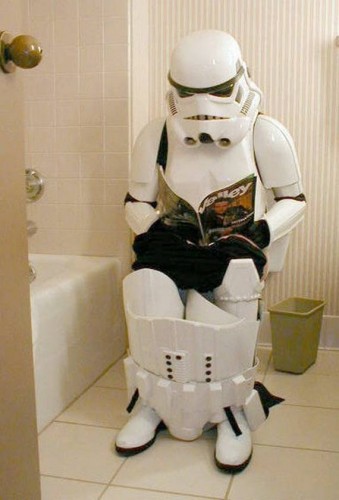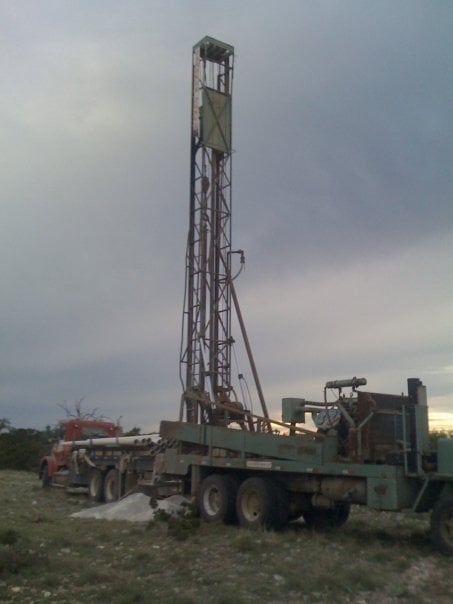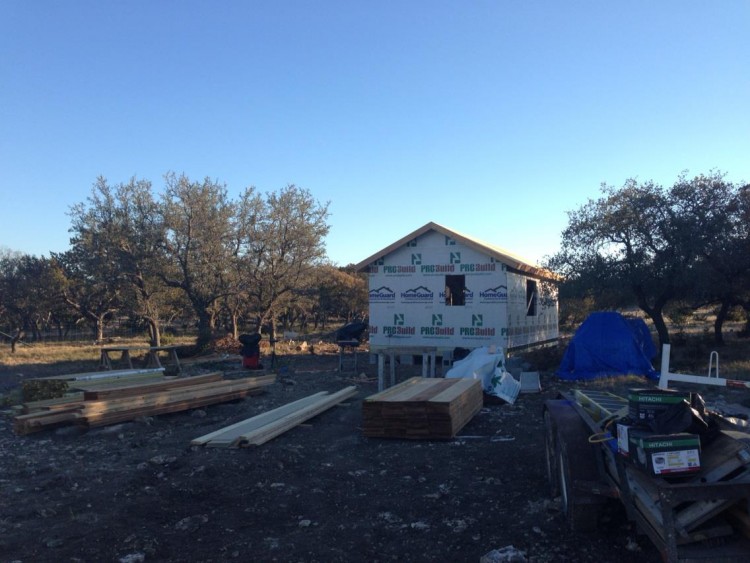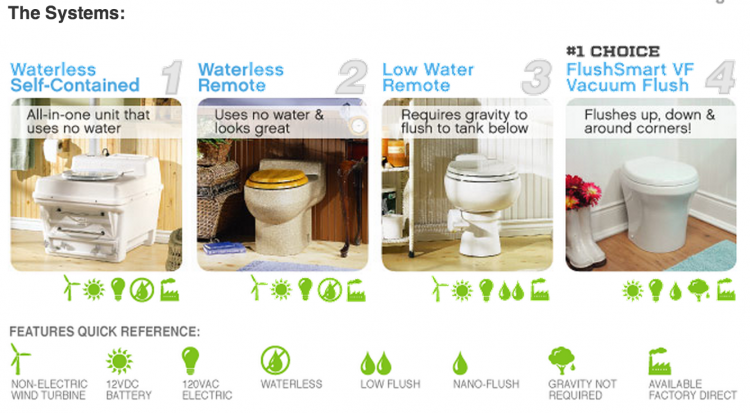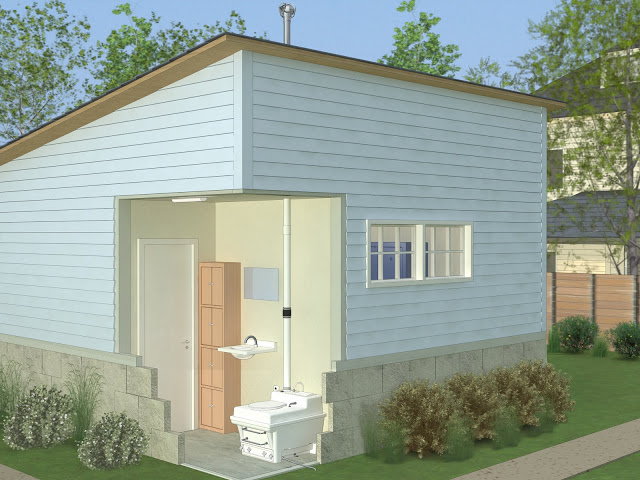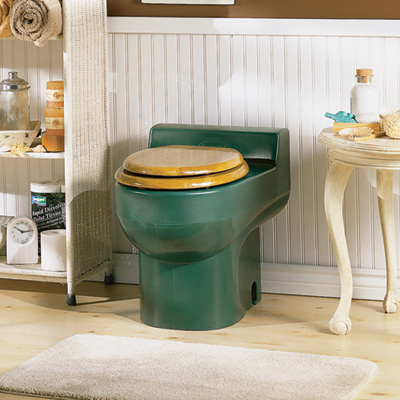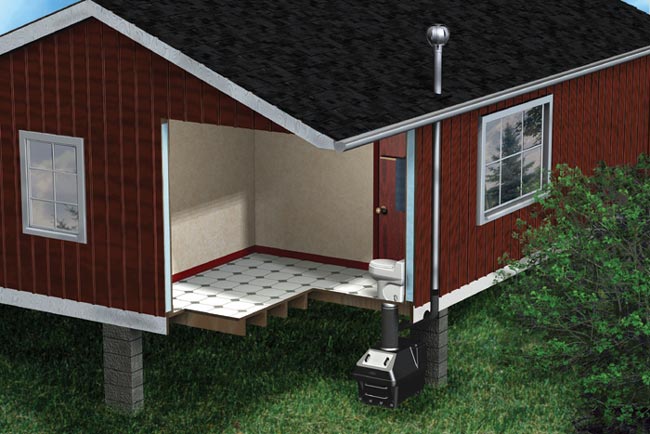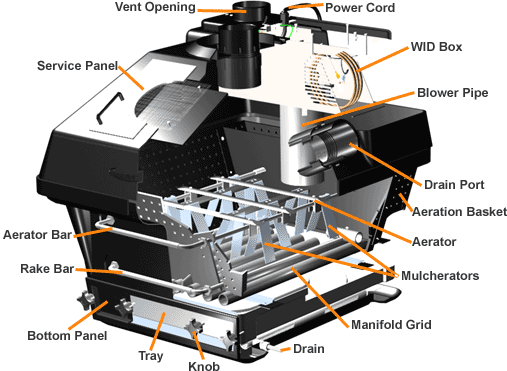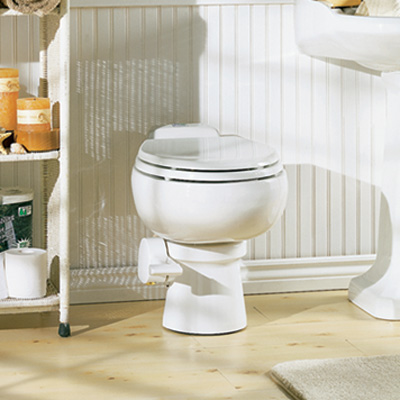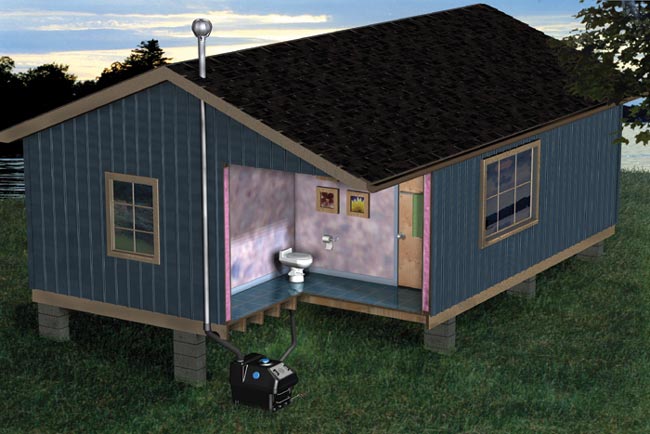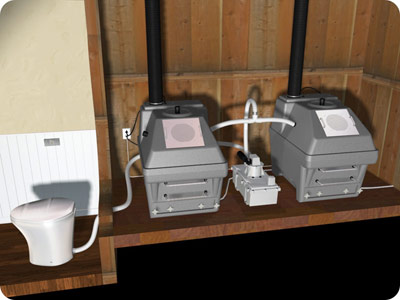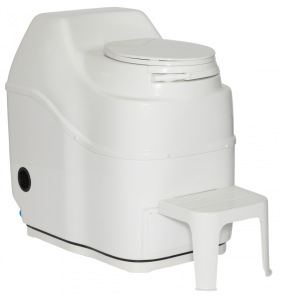Do you live out in the country or off the grid? Have you ever had to contemplate buying, installing, and using one of the many composting toilets on the market? If so, then this post is for you!
Everybody poops. Animals do it, bugs do it, fish do it, and we do it, too.
The only difference between us and the rest of the wild kingdom is that most humans consider poop (ours and other people’s) to be taboo; we don’t want to smell it, we don’t want to see it, we don’t like to talk about it, we certainly don’t want to touch it, and for the most part, we want to pretend that the need to do it doesn’t exist.
We come up with euphemisms for reasons why we need to slip away to take care of business; in polite society, it is considered rude to discuss the events that occur while we are “indisposed”.
When we poop, we want it to disappear tidily, and when a toilet doesn’t properly handle our poop, we panic!
Defecation is a subject that makes people entirely too squeamish, but because it is a human bodily function and a necessity for healthy living, poop disposal is not something that can be ignored.
If you live in a modern city of any size, then you are likely serviced by a city-run sewer system. When you poop, assuming there are no blockages (pun intended) along the way from your house and into the city’s main pipes, your waste is whisked to wherever it is that it goes. Out of sight; out of mind.
Or perhaps you are on a septic system? In that case, again, assuming that there are no issues, your poop is carried straight out of your house and into a buried tank, where microbes, gravity, and time will take over.
Either way — unless there is a problem — after “going,” you don’t usually ever have to give what happens to your poop another thought, right?
One thing that both of these poop disposal systems have in common is that they require a certain type of infrastructure; if installing either type of infrastructure is not economically or geographically feasible, then alternatives must be considered.
This brings us to my story and to the reason for this post …
Before Kev and I could fully commit to moving to the ranch, we had a list of “if this, then that” items that had to be fulfilled.
If we were able to hit water when we drilled our well, then we could progress to the next step — the costly process of putting in almost two miles of rural electric lines.
If we were able to get that done, then we would need to figure out where a septic system could be buried on our rocky hilltop.
If the septic tank couldn’t be installed at our first location choice without blasting or other drastic measures, then we would have to move our site over — as much as a couple of hundred feet to a couple of hundred yards — which is exactly what ended up happening.
Moving our home and septic tank location to a place that didn’t require blasting meant spending about $9000 rather than almost $20,000; it was a no-brainer.
It was one “if this, then that” thing after another, but we eventually got the water well drilled, had the electric line put in, had a septic system buried, and built our home.
It wasn’t long after we had moved in that we realized we were going to need a bit more room. Most of the time, our little house has more than enough space for Kev and me, but when his girls are here, and my daughter is here with her family, well … let’s just say that we have to get pretty creative with the sleeping arrangements.
We really needed a little guest house, somewhere friends and family could stay that would give them privacy while keeping them close enough so that we could enjoy our time together, so we decided to build a two-room cabin.
The cabin’s location is only about 50 yards away from our house, but there was no realistic way to tie it into our existing septic system. Because we didn’t want to spend another $8 to $10 thousand dollars on a septic system that would only be used a couple of times a month, we went into this project knowing that we were going to have to explore alternate methods of waste management.
Building an outhouse was never something we seriously considered; this was 2013, after all. The idea of our family and friends braving the weather and nocturnal creepy-crawlies to hover over a waste pit wasn’t an option; I didn’t want to build or install anything that I wouldn’t be comfortable using myself,
Our friends, Allen and Carolyn, had recently built a bunkhouse at their place; rather than installing a septic system, they had installed a residential composting toilet. They were also in the process of building a cabin, and they were planning on installing another composting toilet.
We figured that’s what we’d do, too … but we put off actually ordering a composting toilet until the builder gave us a heads-up that he was ready to start on the bathroom plumbing. Oops!
After sending a text to Allen to find out what type of composting toilet they had in their bunkhouse (Sun-Mar) and asking if they were still happy with it (they were), I almost placed an order for the same model without exploring any other options.
Thankfully, I stopped myself.
I figured that if we were going to have to service and maintain some weird waterless toilet, we needed to know what we were getting into.
So I began researching residential composting toilets. In the process, I learned that there are many reasons why a compost toilet can be a sound decision beyond a lack of infrastructure, but one of the biggest is because of their ecological impact, or rather — their lack thereof.
Generally, composting toilets require no water (or very little, anyway) to work … think about that for a moment.
Every time you flush the toilet, you are sweeping away your urine, feces, and toilet paper with anywhere from 7 gallons of water (pre-1950s toilets), to 5.5 gallons of water (1960s toilets), to 3.5 gallons of water (1980s toilets), to 1.6 gallons of water (post-1992 toilets).
Now multiply whichever number of gallons matches the age of your home’s toilets by the number of times you use the restroom per day, and then multiply that number by how many people live in your home.
That total number doesn’t even include how much water can be wasted when a toilet is “running” or is otherwise not properly working.
Suddenly, it becomes clear why flushing the toilet is the single highest use of water in the average home and how toilets make up 31% of a household’s overall water consumption (source).
If you live in a state that is urging its citizens to conserve water, it can’t be emphasized enough how devastating toilet flushing is to the water supply.
So whether it is because you live somewhere that is off-the-grid, and you don’t want (or can’t afford) to install a septic tank, or if it’s because you simply want to minimize the amount of water being wasted every time a toilet is flushed in your home, a composting toilet might be the best choice.
But which one should you buy? And wouldn’t a composting toilet smell?
Allow me to digress for a moment …
I have visited quite a few state parks, and I can say that just about every composting toilet I have ever used was basically a glorified port-a-potty or outhouse. Most of them were in remote areas without water or electrical access, and more often than not, they were a toilet seat situated over a hole where everything went into one nasty co-mingled chamber.
In the summer months, they were hot and smelly! <— understatement
But I can think of one exception — the public toilets at the new Mike O’Callaghan–Pat Tillman Memorial Bridge. I only mention it because the experience of using that particular loo made an impression.

This is the view of the Hoover Dam from the Mike O’Callaghan–Pat Tillman Memorial Bridge, and experiencing this is why you must walk across the bridge if you ever get the chance.
We had stopped at the bridge on a family trip one July; it was easily 110ºF outside, but we wanted the experience of walking across it with Kev’s girls. We had already experienced this a few months before with Dan (in much cooler January weather), and we knew the girls would like it.
There was just one problem … I really needed to use the facilities.
What was I thinking? Mid-day in July, on one of the hottest and busiest days of the summer at a popular tourist attraction, there were no plumbed restrooms with air-conditioning. Instead, there were two free-standing concrete outhouses at the edge of a blisteringly hot parking lot.
I considered holding it, calculating how long I could go before my eyes turned yellow, but I knew there was no way I could wait. I resolved to get in and get out of that bathroom as quickly as possible. I went inside the little building, fully expecting the worst: a hot, smelly, dirty, disgusting, and possibly disturbing experience.
But the moment I closed the door, I realized there was something different about this composting toilet from any of the others I had been in. For one thing, it didn’t smell at all!
I attributed that to the exhaust fan that I could hear softly whirring above me from the pipe coming off the back of the toilet. I couldn’t recall being in any others that had used the same type of system.
So that was an eye-opening lesson: if you’re going to have a composting toilet, it should be vented outside directly from the holding container with an always-on exhaust fan; as long as that fan is running, no matter how heavily the toilet is used, the bathroom might not smell.
So fast forward to 2013, when we had to make a composting toilet decision. While doing my research, I found that there were at least six residential brands of composting toilets easily available in the US, each claiming to have a better method or system to deal with captured waste, but there are basically only two types:
- Composting toilets that commingle the captured urine and feces into a common container
- Composting toilets that separate the urine from the feces
Brands that fall into the “commingled” category include Envirolet, Sun-Mar, and BioLet; brands that separate solids from liquid waste include Nature’s Head, BioLet, and Separett.
It’s possible that there are other brands now from when I started this journey, but these are what I had to work with in 2013.
Each of these brands is one that I seriously considered, and each has its pros and cons. I’ll tell you a bit about each of the brands and a few of their models, and I’ll discuss the pros and cons of the different styles and what led me to my ultimate decision.
Of course, if you are seriously looking into installing your own composting toilet, you’ll want to make sure that you install one that meets your specific state’s regulations. You can read more about those here.
Envirolet Composting Toilets
[Update 02/22/24: This company has since gone out of business, so I have removed the broken links.]
Envirolet is probably one of the better-known brands; they have Ed Begley, Jr endorsing them, and they have four models to choose from. You can read their FAQ by clicking here.
Envirolet Waterless Self-Contained – This is Envirolet’s “all-in-one” unit; it doesn’t require a separate holding tank located either under the floor or off to the side somewhere. This is also their ugliest model, a big bulky beast that least resembles a traditional toilet; it looks like an oven to me.

“Envirolet Waterless Self-Contained Systems are “all-in-one” units install right on your bathroom floor. Ideal for ground level or basement installations.”
In order to use this model, you have to hand-operate a bowl trap lever on the right.
This is basically a cover that keeps you from seeing the contents of the bin; the benefit of hand operating it (rather than it being activated by sitting on the seat) is for the convenience of men who generally stand when urinating.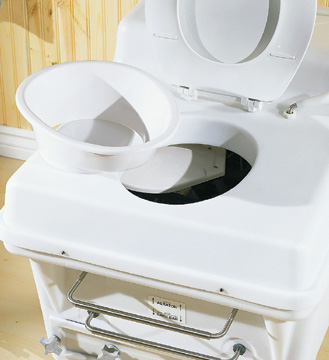
All Envirolets are vented toilets, and they require the installation of a vertical exhaust; on this model, in particular, both the non-electric and 12-volt battery versions are fitted with a “special filter drain that must gravity feed to a proper drain site.”
What’s going on inside the bins under the toilet? Composting action, that’s what. Microbes that you periodically add to the peat and other biodegradable matter contained inside are working on the poop, while the exhaust fans are working to evaporate liquid waste.
According to Envirolet, “90% of all toilet waste is water, the balance is organic material.” And once that organic material has been composted, you’ll need to empty the drawer “as little as once a year using the built-in Rake Bar (the bottom bar on the front of the Envirolet), the recycled waste is raked down into a collecting tray and a small amount of natural compost is emptied into your garden, completing nature’s cycle.”
Microbes that you periodically add to the peat and other biodegradable matter contained inside are working on the poop, while the exhaust fans are working to evaporate liquid waste. According to Envirolet, “90% of all toilet waste is water, the balance is organic material.”
And once that organic material has been composted, you’ll need to empty the drawer “as little as once a year using the built-in Rake Bar (the bottom bar on the front of the Envirolet), the recycled waste is raked down into a collecting tray and a small amount of natural compost is emptied into your garden, completing nature’s cycle.”
This toilet is able to accommodate up to eight people going three times a day, and single-ply or bio-degradable toilet paper is recommended.
It retails for $2290.75 to $2460.75, depending on the options chosen.
Envirolet Waterless Remote – With this system, you get to have a more traditional-looking toilet (albeit one made of durable, easy-to-clean, high gloss HDPE plastic rather than porcelain) located in the bathroom …
… but you must have a place directly below the bathroom (a basement or a tall crawl space) for the remote composting unit.
What’s going on inside the remote composting unit? Grinding, chopping, and mulching, all aided with the use of periodically added peat moss and microbes.
This looks like a pretty high-tech way to compost poop, doesn’t it? You can read more about the Science & Technology Behind Envirolet here [link removed]. That basically covers the same remote composting action found in all of the Envirolet styles other than the waterless self-contained model.
This toilet is rated for up to ten persons per day, going three times a day, and single-ply or bio-degradable toilet paper is recommended.
It retails for $2715.75 to $2970.75, depending on the options chosen.
Envirolet Low Water Remote – This toilet is a ceramic low-flush model that uses about a pint of water per flush; it has a gravity-fed remote composting unit below. You are able to install up to three low-flush toilets per low-water remote system.
If you just can’t reconcile yourself with the idea of having a blocky plastic toilet or using a toilet without being able to flush, then the Envirolet Low Water Remote system might be the one for you. If you are trying to go waterless, however, you’ll want to keep looking.
So the biggest difference here from the previous model is that you get ceramic instead of plastic, and a small bit of water is added to the system every time you flush. I’m not sure how much (if any) extra stress that extra water adds to the composting mix downstairs, but it might be something to consider.
This toilet is rated for up to ten persons per day, going three times a day, and single-ply or bio-degradable toilet paper is recommended.
It retails for $2800.75 to $3055.75, depending on the options chosen.
Envirolet FlushSmart VF – The last Envirolet model I’ll talk about is the “primo” version. Not only do you get a ceramic vacuum flush toilet that can be installed almost anywhere due to its ability to flush down, horizontally, or even up to the remote composting system using a vacuum generator.
That’s pretty spiffy, especially if you don’t have a basement or tall crawl space.
In 2013, there were eleven different models to choose from, including models with single or double composting tanks. Double composting tanks seem like a good idea, assuming you have the room, simply because guessing how much waste processing and storage you’ll need isn’t something you’d want to guess incorrectly about.Here’s a video of it in operation …
This toilet system is rated for up to ten persons per day, going three times a day if a single tank is installed, or up to 20 people per day going up to three times a day with a double tank installed. Again, single-ply or bio-degradable toilet paper is recommended.
This system retails for $4500.75 to $7050.75, depending on the options chosen.
Envirolet Composting Toilet Pros:
- Ability to add a remote collector for the compost
- Available in models that use no water or very little water
- Models that can flush to the remote compost collector in angels other than straight down only
- The low-water models are available in ceramic
- Fans can run on AC or DC power
Envirolet Composting Toilet Cons:
- Insects (!!)
- A vertical vent is required
- Toilets with remote compost collectors usually require a basement under the toilet or tall crawl space.
Sun-Mar
Sun-Mar is the brand that our friends Allen and Carolyn had installed in their bunkhouse, and it was also the brand that they were considering installing in their new cabin. Sun-Mar has three styles of composting toilets, with numerous models under each style. You can read their FAQ here.
This video sums up the working of their various composting toilet systems:
Sun-Mar’s Self-Contained Systems
Sun-Mar touts their Excel as “the best-selling unit in North America”. They say that it “is a high-capacity Bio-drum toilet that is very simple to operate, features well-proven technology, and is extremely reliable.” The Excel was also the “first-ever self-contained composting toilet to be certified by the National Sanitation Foundation (NSF).”
Available in white or bone, the Excel can be installed in homes where there is no electricity or in completely off-the-grid applications with the NE version, which uses no electricity.
The beauty of this model is that it is completely self-contained, so all the composting action is going on inside this main unit … which does mean it is kind of tall and a bit odd-looking. But if you are used to using an outhouse at your cabin or off-the-grid home, you probably aren’t going to gripe too loudly about this.
Once again, you are getting an odd-looking toilet that is predominantly made of fiberglass, and there is a compost bin in the bottom. A vent is attached to the back of the Excel that runs through the wall and up the outside wall.
For comfort the Excel has a sturdy detachable footrest which can be removed to pull out the finishing drawer.
What’s going on inside the self-contained system after the initial startup?
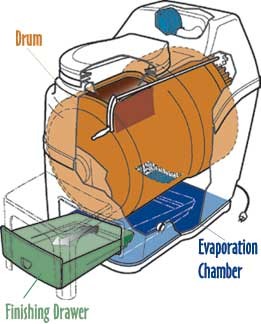
You’re collecting solid and liquid waste and basically creating compost inside a drum and evaporating any liquids in their own chamber. There are several different levels where the composting is occurring, and the oldest level (most finished) is the one that you will periodically have to remove from the finishing drawer.
You typically empty some of the compost out of the drum once per year for cottage use, once every few months for residential use. In cases of continuous use, you may extract some compost more often. This always sits in the drawer to cure before being removed – you are never handling any fresh waste when the unit is properly operated.
You’re supposed to add 1 cupful (or two handfuls) of peat moss mixed with wood shavings (60% wood shavings, 40% peat moss, or Sun-Mar’s Compost Sure peat mix with hemp) after every bowel movement; Sun-Mar says that this “usually represents one cupful per person per day of use.” but obviously your mileage may vary. You also have to do a manual rotation of the drum “three times a week when in use, or, if used only at weekends, only on departure.”
The Sun-Mar Excel is rated to handle three adults or a family of up to five people for residential use, and for seasonal use, it can handle six adults or a family of up to eight people.
It’s super important to always keep that vent running; otherwise, you might find that you have bugs. That happened to Allen and Carolyn once.
What’s nice about this system is that adding toilet paper is a good thing (it helps with the composting), and urine is considered a necessary part of the mixture, so men aren’t expected to urinate outdoors or in an outhouse (country living, y’all!).
This system retails for $1895.
Sun-Mar’s Central Composting Toilet Systems
Sun-Mar’s CENTREX systems come in three configurations that mainly have to do with capacity; they all require a water source for the 1-Pint Flush Toilet that will be installed in your bathroom unless you go with a waterless system.
A simple foot pedal flush opens the water valve and gate when pushed down, and fills the bowl with water when lifted. After flushing, a small amount of water is held in the toilet bowl which is sealed by a self-cleaning ball valve and teflon seal.
Even gravity-fed water from a roof tank is sufficient to flush a 1 pint flush toilet. In winter they can be flushed manually using a container if necessary.
If you have a seasonal cabin, then you might be able to get by with the CENTREX 1000, which is rated for five to seven adults using it on weekends or on vacation only. The CENTREX 2000 is rated for four to six people for residential/continuous use or seven to nine people for weekend and vacation use.
The CENTREX 3000 is the largest unit, and it can handle six to eight people for residential/continuous use or nine to 11 people for weekend and vacation use.
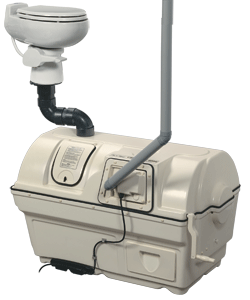
The mid-size CENTREX 2000.
Each of the three CENTREX systems requires installing a separately purchased 1-pint Flush Toilet (it will work with all three models) in the bathroom and the composting bin goes under the floor in an accessible crawl space.
There is an option of making the CENTREX 2000 or 3000 waterless by purchasing the $335 Dry Toilet or the $460 Elongated Dry Toilet.
You’ll have to periodically remove the produced compost, and there is a heating unit/vented fan that will also have to be installed to remove evaporating liquid and odors.

All central low flush systems are supplied with a 1″ drain hose which should be connected to the 1″ drain at the bottom left of the unit. Liquid output should be collected or drained into an approved facility.
The CENTREX systems retail for $1845 to $2245, plus $381 for the 1-Pint Flush Toilet (made of porcelain) or either of the aforementioned dry toilets (depending upon which kit you buy).
One of the cool things about this system is that you have options for dry or water toilets, and they have options for electric and non-electric use. The benefit of using the 1-Pint Flush toilet is that you can install more than one toilet per CENTREX unit; if you go the dry-toilet route, the toilet must be installed directly above the CENTREX unit.
Sun-Mar has a handy question process if you aren’t sure which system would work best for you.
Sun-Mar Pros:
- You have the option of picking a self-contained unit or a CENTREX Unit
- The CENTREX 2000 and 3000 allow the option of using multiple 1-pint flush toilets or a single dry toilet per CENTREX unit
- CENTREX units offer the option of AC or non-AC use
- If you don’t keep the fan running, you may get insects
Sun Mar Cons:
- Sun-Mar’s FAQ says that composting does not occur during the winter (unless the unit is in a heated area kept at 55ºF or higher).
BioLet
BioLet composting toilets are engineered and built in Sweden; they have been around since 1972, and all of their designs are waterless. There are two basic systems offered: the BioLet Composting toilet and the BioLet Separating Toilet.
Available in three sizes, the BioLet Composting Toilets are self-contained systems that create compost from your waste. They have a handy FAQ that you can check out here, and you can learn more about how they work here.

Each of their composting toilets is an automatic electric toilet. When you sit on the toilet, a trap door is opened.
Closing the toilet seat lid activates the stainless steel mixing mechanism that efficiently breaks down paper and distributes moisture into the compost material in the upper chamber. Material in the upper chamber is finished in the lower chamber and eventually emptied. The BioLet 65 features LED maintenance indicators to let you know when it is time to empty the lower chamber. The non-composted portion and the dry, composted portion are kept separate.
An electric fan is continuously circulating warm air under and around the compost for “fast decomposition and evaporation of liquid. A float switch operates an additional bottom heater if any excess liquid is detected. Once a week or as needed, mulch is added through the toilet seat opening.”
So there’s some basic maintenance that has to be done, as with all self-contained composting toilets, but it’s not too serious. BioLet Composting Toilets are made of polished polystyrene ABS plastic, and they are supposed to be relatively easy to install. Some things that you should know include:
- When the toilet is in use room temperature must be at least 18°C.
- If you are away for more than two days, you should always switch the power off and place the cover over the seat opening, otherwise, the compost will become dry. The moisture content is an important component of the biological process, so it is important to retain the moisture as long as possible, even when the toilet is switched off.
- Apart from the natural needs being taken care of during a visit to the toilet, the only thing that should go into the toilet is toilet paper.
The BioLet Composting Toilets range in price from $1899 to $2799.
BioLet Separating Toilet
[Update 02/22/24: This model is no longer available, so I have removed the links]
If you don’t have a reliable electric source, then you’ll want to look at the BioLet Separating Toilet. Rated for full-time use by three people or part-time use by 4 people, the BioLet uses composting bins; when the bin fills, you remove it and place it outside for further composting and place another bin inside the toilet.
Equipped with a convenient drain tube, the BioLet 30NE drains off any excess liquids to an auxiliary container, French drain or leach field. Since liquids are not a limiting factor, the BioLet 30NE will allow for applications where a larger capacity may be needed.
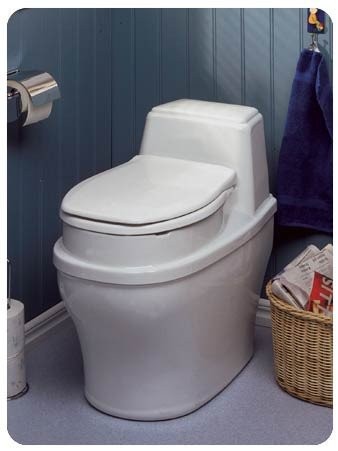
Bear in mind that if you don’t have an electric source and therefore can’t install a fan, there may be odors.
The BioLet Separating Toilet sells for $1399.
Nature’s Head
One of the least expensive composting toilets I’ve seen is the $925 Nature’s Head. It’s not going to win any beauty contests, but it is completely self-contained, and it will work well in a tiny home, cabin, workshop, or RV. 
Nature’s Head uses urine diversion, which means that you are actually trapping urine that needs to be disposed of and keeping it away from the solid waste that will eventually be turned into compost. This helps keep odors down (this is a case where fermentation is not your friend).
The installation looks pretty simple; here’s a video that they posted that shows the process.
According to Nature’s Head:
There is one ventilation hose to run outside and one 12volt power hook-up for a small computer type fan. The unit could even be run completely powerless by running the vent hose to a solar vent.
The cleanout is supposed to be pretty simple, too:
When it’s time to empty your toilet simply flip the two latches on the sides and lift the upper section up a few inches. Put the lid on the liquid bottle and lift it out of its holder. To empty the main tank un-hook the 12 volt power connector and the vent hose and then slide the upper section off its open ended hinge. Undo the 2 thumb screws on the base and it’s ready to empty.
Because there are no liquids in the main tank, even full it is never heavy. The unit is sized so that a kitchen garbage bag will go over the end of the main tank. Simply flip it over and you’re done. There is no need to clean the tank when you empty it, any left-over matter will help start the composting process all over again.
What doesn’t appeal to me is that you have to empty the liquids yourself, which might be fine and expected if you were installing this in a boat or RV, but for home use — where is that liquid supposed to go?
Nature’s Head says that urine is “great for mature trees, or can be diluted for plants. Ideally, the compost section would be emptied in a compost pile or bin. If traveling, it can be disposed of in a bag or buried.”
I guess it depends on where you are and if there are any local regulations against pouring urine on nearby trees, but I wasn’t thrilled with the prospect of having to regularly empty out a urine container on top of having to deal with the accumulated waste. Personal preferences and all.
Separett
The $1389 Separett Villa is the composting toilet that we ultimately decided to install. As the name implies, the Separett separates the liquid from the solid at the start, so there are no odors from sewage fermenting; a constantly running low-voltage vent fan also functions as the exhaust fan for the bathroom.
There are no temperature restrictions to use the Separett, and it looks similar to a real toilet, even though it’s not quite the same. They also offer an AC/DC model and an $899 Tiny model for those with limited space.
The Separett allows liquid waste to exit and dilute with your gray water (water produced from your sinks, shower, and washing machine), becoming instant nitrogen-rich fertilizer; we’ve been diverting this greywater to the live oak trees and grass about 30 feet away from the front of our cabin since the installation in 2013 —the trees are thriving.
There is no other handling of the urine necessary. If you prefer (or if local ordinances require it), you can instead route the water to a soakaway or collection tank.
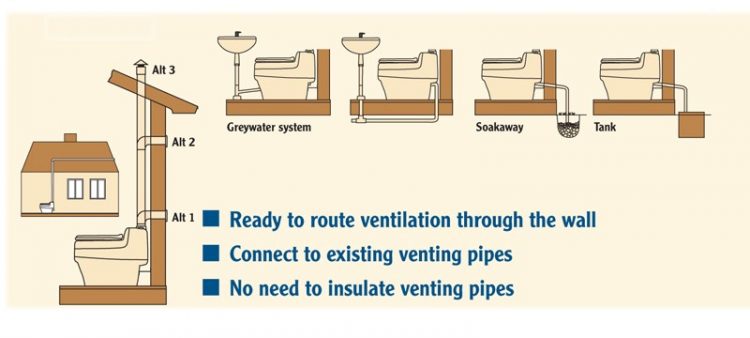
The solid waste and toilet paper (you can put any and all kinds of TP in there) are collected in a large removable bucket that is held out of sight inside the base of the Separett.
Each time you use the toilet, the bucket is rotated under you, and an exhaust fan is constantly blowing on the feces, which helps keep bugs away and also helps it dry out a bit.
When the bucket is eventually full, you’ll remove it from the toilet, put the lid on it, and set it to the side of your house (in full sun if possible) to allow the contents to compost for 6 months. At that point, they are ready to mix into your compost bin or bury in the dirt for what will eventually become nutrient-rich compost.
What happens with the solids inside the container during the 6 month storage period?
Note, however, that this method does not produce ready-to-use soil. What happens is that the bacteria in the soil “consume” the faecal pathogens, thereby rendering the content harmless. It is then ready to be composted or buried in order to decompose fully.
Toilet paper can still be seen after six months, but will rapidly disappear when the content is composted or buried. How do I compost the solids? After the 6 months storage period, you can compost the content in a normal composting bin, a garden compost heap, or a pile of leaves.
If you use a compost bin made for latrine (waterproof bottom and lid) it is not necessary to store the solids in the container. Instead it can be put straight into the compost bin without being stored in the container first.
The extensive comments on this article (and yes, I read every one of them) coupled with several other articles I found online about the benefits of a separating compost toilet system led me to think that this would be the best solution for us.
We installed the Separett in 2013, and when our cabin was only being used occasionally, it worked exactly as advertised — roughly 6 months before it needed to be emptied (sometimes longer), and there was a perfect separation of liquid and solid waste.
Even if no one was staying in the cabin, the fan was always left running, and there were never any odors. We would empty the bucket inside the toilet once every six months or so and set it to the side of the house for further composting.
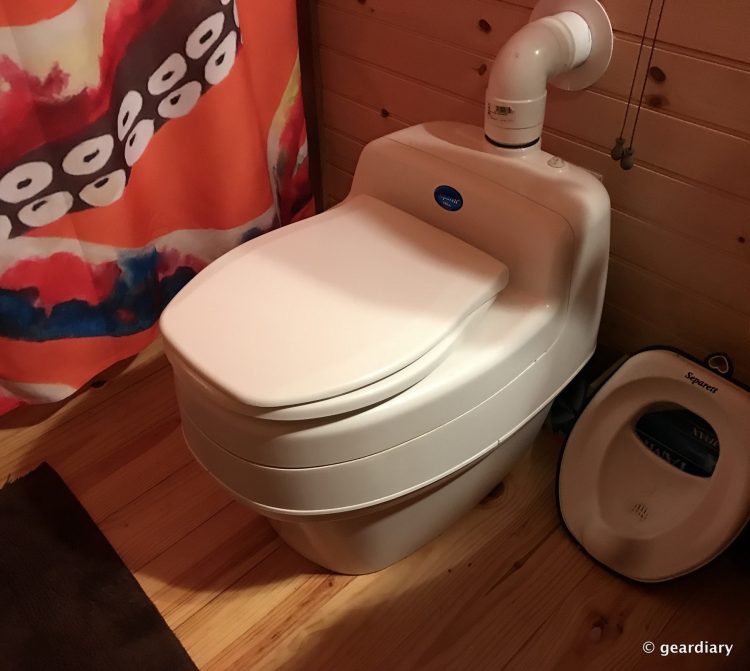
The Separett toilet is made of “impact-resistant high-gloss polypropylene”, which the company says is recyclable. It comes with a 5-year warranty.
Eventually, we added three bedrooms to the cabin, and my daughter and her three girls moved in full-time. When the little girls use the toilet, they know to add the kid’s seat to make sure that their urine is diverted to the proper area.

Separett says that when four people are using the toilet full-time, the bucket will need to be emptied roughly every 3-4 weeks, and that’s proven to be true. We’ve simply ordered more buckets and liners to keep up with the increased demand, which is something you can’t do with one of those all-in-one composting toilets.
 The one thing to remember with this toilet is that if you usually stand to pee, you simply can’t.
The one thing to remember with this toilet is that if you usually stand to pee, you simply can’t.
You either have to sit while peeing to make sure that it goes into the front urine compartment, which feeds into the greywater pipe, or you can do as most men in the country do and pee outside — hey, it helps keep the deer and other varmints away.
I know this isn’t something that people in the city would likely find appealing, but most people in the city would never have to consider using a compost toilet in the first place.
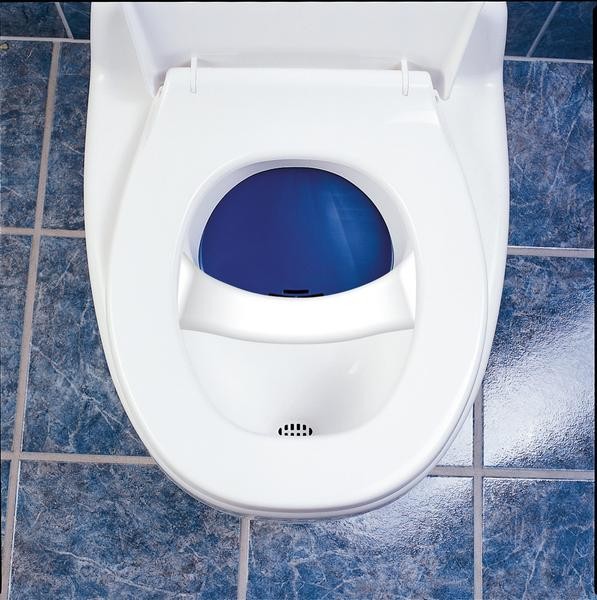
When you lift the lid on the Separett, a handy blue flashing covers the solids composting bucket, so you never see its contents. Sitting on the seat causes the blue cover to slide to the side so you can use the toilet as you usually would.
I’m not going to lie: when you have to empty a bucket full of poop every 4 weeks or so, it’s no fun. The contents aren’t nearly as dry as they would be if the toilet was getting more sporadic vacation or weekend use (I remember fondly the days when the bucket only needed to be emptied every 6 months or so), but a pair of rubber gloves and holding one’s breath will get you through a lot of things.
Remembering that adding a separate septic system for the cabin will be $9,000+ (due to the rocky area) also makes this much more bearable.
In the roughly four and a half years that we’ve been using the Separett, it has never given us any trouble; the only time the bathroom has ever smelled funky was when one of the grands accidentally flipped the button that runs the fan off; that mistake was soon found and corrected.
The only other issue was when the grands weren’t scooting quite far enough up in the kids’ seat when peeing (causing the bucket to fill with urine and feces – nasty!), and that was also corrected.
Our friends Allen and Carolyn purchased a Separett to put in their ranch house after I’d told them about all the research I had done on the subject; theirs was also installed in 2013.
In preparation for this long-overdue article (I’ve been working on it since 2013, you see), I asked Allen if they had ever had any issues with theirs in the years they’ve had it, and he said:
We haven’t had any issues with the Separett unit (Ranch House), and no issues with the Sun-Mar unit (Bunk House) either. However, I like the Separett unit best.
At $1389, the Separett Villa 9200 AC has been a very practical purchase for us. We have 6 or 7 extra composting buckets ($49.90 each) that we keep in rotation, and once the contents have been properly composted for 6 months or so in full sun, we can then compost or bury the result.
We also buy the composting liner bags and the Absorb pads that go inside the composting tub liner; they help keep the buckets “clean” (relatively speaking, of course) and absorb any extra fluids. You can read the FAQ about Separett composting toilets here.

I like the idea that in drought-prone West Texas, we aren’t adding a burden to our ecosystem. In fact, we have found a way to help the trees nearby that wasn’t available before. Even better, the resulting humanure compost (yes, that’s a thing!) is being put to use as fertilizer for our live oak trees, too; it’s an ecological win all the way around.
•••••
So there you have it: it is possible to put a well-functioning composting toilet into a place with no infrastructure — without installing an expensive septic system and without having to deal with any unwanted odors.
Yes, there is a bit of maintenance that must be done, and there is a learning curve for the younglings, but it has all worked out better than we could have possibly hoped.
Do you use one of these composting toilets? If so, which one? Do you have any horror stories or tips that you’d like to share? Do tell!

